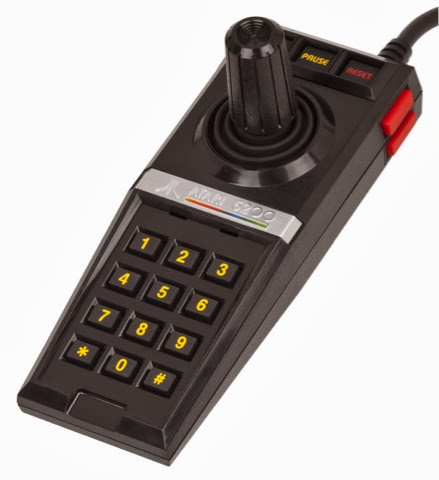After the Atari 7800, Atari figured that it’s numbering system was a bit outdated. I think getting into five digits also made it seem a bit ridiculous since Atari 10400 would have been next. So in an era of Super Nintendo, and Genesis, a name had to be created for Atari’s next console. Since the code name of the project already introduced a cats name, “Panther”, sticking with jungle cats just seemed natural and in 1993 the “Jaguar” was released.
Now, as I previously said Atari was known for making bad decisions and the Jaguar was the coffin nail of bad decisions. First of all like the 5200, the Jaguar had a terrible controller and as a matter of fact the Jaguar controller looks like an evolved version of the 5200’s
strange number pad, oddly placed firing buttons and all.
With that said though, the actual major downfall of the Jaguar and Atari as a console maker, isn’t because of its controllers. In reality it’s partly because it was offering a product ahead of its time, and partly due to its marketing. Atari knew after Gen 4 that it was no longer a player in the console market. Sega had stepped up in their place with the Genesis, and the Atari 7800 had been a minor success in Gen 3, but Nintendo had left its mark as king of that generation. So to counteract this and establish a beachhead in Gen 5 Atari had to put something out there that was revolutionary. In a way they did, the Jaguar was 32-bit in a 16-bit era. It seems like desperation kicked in and Atari marketing took it too far though. The system was marketed as being 64-bit, which at the time would have made it almost a generation ahead of its competitors. The only issue was that, in essence it wasn’t 64-bit, and performed a little like existing 16-bit systems, and even more closely to Sega’s 32X which was to come a few years later. So the Jaguar produced a 32-bit experience which made it ahead of its time, but by no means was it 64-bit.
If now days you were to look at the Jaguar, and compare it to an N64 or PS1 you would see that its graphics are definitely not 64-bit. The claim of the Jaguar being 64-bit would actually draw some criticism from those in the industry, since the systems CPU was 32 and not 64-bit, but it’s graphics processes where. This “technically 64-bit” controversy was a major turn off to consumers, who felt Atari’s claims where misleading. We can only theorize that if Atari had claimed the Jaguar was a 32-bit system instead of a 64 they may have been able to still stay ahead of the crowd while maintaining consumer trust but even that is debatable.
The main debate takes place on whether Atari was in fact trying to deceive consumers or not. At the time there was nothing that provided either a 32 of 64-bit experience on a home console. This means that in marketing the Jaguar, Atari may have honestly believed it was producing and selling a 64-bit system. Many current Jaguar fans argue that Nintendo and Sega may have made a larger issue out of the Jaguar’s technical specifications then need be, in order to prevent the more advanced system from gaining market share and possible dominance from over them. Jaguar fans also argue that had the system had a longer lifespan if it’s games would have evolved to take advantage of its 64-bit capabilities.
Unlike the 5200 where the market could be blamed, the Jaguar’s failure is purely based on poor decision making by Atari corporate. At the time consumers already looked at Atari as being a name from the past, so for them to sudden jump back into the market with a system supposedly 4 times more powerful than what was already out there, had to really draw suspicion from gamers, and as history tells us it did. The Jaguar was one of the worst selling consoles in home gaming history selling only a quarter as many units as Atari’s previous failure the 5200, and it would seal Atari’s fate, ending its future in console gaming.
Today, the Jaguar has a loyal following and looking at eBay, Jaguars sell at almost the same price the where released at in 1993, in the $200 range. This is probably also because so few systems sold and/or were made, that they’ve become collectors items. But, Jaguar owners are a fearsome bunch who have established clubs and even conventions for their beloved last true gaming console of Atari’s, and still believe their system wasn’t given the chance it needed in order to prove itself.
I would like to say time will tell, but 20 years have passed and the Jaguar is a forgotten system. It seems to only be remembered in retro circles, and even somewhat laughably by those who don’t know much about it.
The Jaguar, like the Sega 32X and CD, and the Atari 5200, was a true mezzanine system. It was too advanced to be placed in with current systems, but too far ahead of its time to be connected with the next generation. In a way these systems were doomed before the hit the market, and market forces only helped in adding pressure to end these systems lives before the could even start.
Looking at the products 18 or more years in the future as we currently are we can only assign “what if” theory’s to these systems and companies. What I truly think we fail to realize though is that the video game market is a fragile micro-economy. Unpredictable market turns, changes in consumer tastes/product perceptions, and bad decisions on the part of a manufacturer, can all push a console and/or it’s manufacturer into oblivion.



Leave a Reply